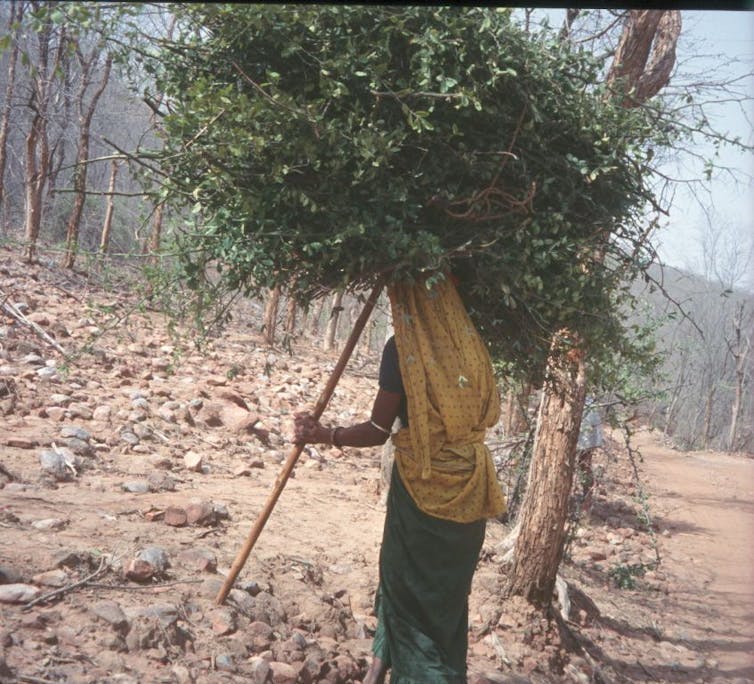British colonialism turned India’s tigers into trophies. Between 1860 and 1950, greater than 65,000 had been shot for his or her skins. The fortunes of the Bengal tiger, certainly one of Earth’s greatest species of massive cat, didn’t markedly enhance post-independence. The searching of tigers – and the animals they eat, like deer and wild pigs – continued, whereas massive tracts of their forest habitat turned farmland.
India established Mission Tiger in 1972 when there have been fewer than 2,000 tigers remaining; it’s now one of many world’s longest-running conservation programmes. The undertaking aimed to guard and improve tiger numbers by creating reserves from current protected areas like nationwide parks and wildlife sanctuaries. A part of that course of has concerned forcing individuals to relocate.
In protected areas globally, nature conservationists can discover themselves at odds with the wants of native communities. Some scientists have argued that, to ensure that them to thrive, tigers want forests which can be utterly free of people that may in any other case graze livestock or gather firewood. In a number of documented instances, the tiger inhabitants has certainly recovered as soon as individuals had been faraway from tiger reserves.
However in pitting individuals in opposition to wildlife, relocations foster larger issues that don’t serve the long-term pursuits of conservation.
India’s Relocation Coverage
Below Mission Tiger, 27 tiger reserves had been established by 2005, every spanning someplace between 500 and a couple of,500 sq. kilometres. Tiger reserves have a core by which persons are prevented from grazing livestock, searching wildlife and gathering wooden, leaves and flowers. A buffer zone encircles this. Right here, such actions are allowed, however regulated.
About 3,000 households had been relocated from these core zones within the first three many years of the undertaking, and from 2005 till 2023, about 22,000 households had been moved. Most relocations had been involuntary and a few plunged these ousted into deeper poverty.
In Sariska tiger reserve in Rajasthan, northwestern India, the primary relocation was made throughout 1976-77. A few of the households returned to the reserve after being given land unsuitable for farming as compensation. This was a poor commercial for relocation which few different communities opted for voluntarily.
After they had been moved from Rajaji tiger reserve in 2012, Gujjar pastoralists who make their dwelling grazing buffalo had been prompted to take up farming on new land. With little expertise in agriculture, and having been denied their conventional supply of earnings, many struggled to regulate.
The Gujjar did no less than acquire entry to water pumps and electrical energy. In a single case, within the Bhadra tiger reserve in Karnataka, southwestern India, relocation was much less painful as individuals had been supplied high quality agricultural land who already had prior farming expertise.
Most individuals who misplaced their proper to graze livestock or gather forest produce in newly established tiger reserves went on to labour in tea and low plantations or factories.
Regardless of widespread relocations, the tiger inhabitants in India continued to plummet, reaching an all-time low of fewer than 1,500 in 2006. Tigers turned extinct in Sariska and Panna tiger reserves in 2004 and 2007 respectively.
Native extinction in Sariska prompted the federal government to enlist the assistance of tiger biologists and social scientists in 2005. This job drive discovered that unlawful searching of tigers was nonetheless occurring, their claws, tooth, bones and pores and skin harvested to be used in Chinese language medication. Mining and grazing had additionally continued inside many reserves.
Corridors Of Energy
The tiger job drive acknowledged that having the area people onside helped forestall unlawful searching and forest fires. The Soliga tribes of Biligiri Rangananthaswamy temple tiger reserve in Karnataka determined to not relocate when supplied compensation, however as an alternative took up work rooting out invasive crops like lantana and curbing unlawful searching and timber felling. The Soliga are among the many only a few communities who’ve been rewarded with rights in tiger reserves.
Equally, in Parambikulam tiger reserve in Kerala, a state on India’s tropical Malabar coast, communities that weren’t relocated discovered work as tour guides and forest guards. Individuals right here have supplemented their earnings by gathering and promoting honey, wild gooseberry and medicinal spices, below the joint supervision of the group and forest division officers. Many households have been in a position to surrender cattle rearing because of this, lowering grazing strain on the forest.

Regardless of these successes, the federal government’s coverage of relocation stays.
Tiger numbers have recovered to greater than 3,000 as of 2022, however Mission Tiger exhibits that relocation alone can’t preserve tigers indefinitely.
An important alternative awaits. Over 38 million hectares of forest, appropriate tiger habitat, lies outdoors tiger reserves. Declaring these forests “corridors” that enable tigers to maneuver between reserves might cut back the danger of inbreeding and native extinction and reinforce the restoration of India’s tigers.
Research in sure tiger reserves present that enormous numbers of villagers would help additional relocations if it meant getting access to consuming water, colleges, healthcare and jobs in resettlement websites. A portion of the US$30 million (£22.7 million) spent yearly by Mission Tiger must be used to make relocations truthful. Or higher but, promote the form of community-based conservation nurtured within the Biligiri Ranganathaswamy temple and Parambikulam tiger reserves.
(Authors: Dhanapal Govindarajulu, Postgraduate Researcher, World Growth Institute, College of Manchester; Divya Gupta, Assistant Professor, Binghamton College, State College of New York, and Ghazala Shahabuddin, Visiting Professor of Environmental Research, Ashoka College)
(Disclosure Assertion: The authors don’t work for, seek the advice of, personal shares in or obtain funding from any firm or organisation that may profit from this text, and have disclosed no related affiliations past their educational appointment)
This text is republished from The Dialog below a Artistic Commons license. Learn the unique article.
(Aside from the headline, this story has not been edited by NDTV workers and is printed from a syndicated feed.)